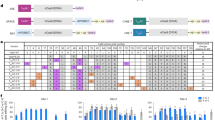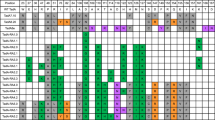Abstract
Adenine base editors (ABEs) catalyze specific A-to-G conversions at genomic sites of interest. However, ABEs also induce cytosine deamination at the target site. To reduce the cytosine editing activity, we engineered a commonly used adenosine deaminase, TadA7.10, and found that ABE7.10 with a D108Q mutation in TadA7.10 exhibited tenfold reduced cytosine deamination activity. The D108Q mutation also reduces cytosine deamination activity in two recently developed high-activity versions of ABE, ABE8e and ABE8s, and is compatible with V106W, a mutation that reduces off-target RNA editing. ABE7.10 containing a P48R mutation displayed increased cytosine deamination activity and a substantially reduced adenine editing rate, yielding a TC-specific base editing tool for TC-to-TT or TC-to-TG conversions that broadens the utility of base editors.
This is a preview of subscription content, access via your institution
Access options
Access Nature and 54 other Nature Portfolio journals
Get Nature+, our best-value online-access subscription
$29.99 / 30 days
cancel any time
Subscribe to this journal
Receive 12 print issues and online access
$209.00 per year
only $17.42 per issue
Buy this article
- Purchase on Springer Link
- Instant access to full article PDF
Prices may be subject to local taxes which are calculated during checkout





Similar content being viewed by others
Data availability
High-throughput sequencing data have been deposited in the NCBI Sequence Read Archive database (https://www.ncbi.nlm.nih.gov/sra) under accession number PRJNA661167. RNA-seq data have been deposited in the Gene Expression Omnibus under accession GSE165164. Plasmids encoding ABE8eWQ (Addgene no. 161815), ABE-P48R (Addgene no. 161816) and ABE-P48R-UGI (Addgene no. 161817) engineered in this work are available on Addgene at https://www.addgene.org/Sangsu_Bae/. Any other additional relevant data are available from the authors upon reasonable request. Source data are provided with this paper.
Code availability
The authors declare that all unreported custom python code used in this study are available within the article or from the corresponding author upon reasonable request.
References
Gaudelli, N. M. et al. Programmable base editing of A*T to G*C in genomic DNA without DNA cleavage. Nature 551, 464–471 (2017).
Jeong, Y. K., Song, B. & Bae, S. Current status and challenges of DNA Base editing tools. Mol. Ther. 28, 1938–1952 (2020).
Kim, D., Kim, D. E., Lee, G., Cho, S. I. & Kim, J. S. Genome-wide target specificity of CRISPR RNA-guided adenine base editors. Nat. Biotechnol. 37, 430–435 (2019).
Liang, P. et al. Genome-wide profiling of adenine base editor specificity by EndoV-seq. Nat. Commun. 10, 67 (2019).
Rees, H. A., Wilson, C., Doman, J. L. & Liu, D. R. Analysis and minimization of cellular RNA editing by DNA adenine base editors. Sci. Adv. 5, eaax5717 (2019).
Grunewald, J. et al. CRISPR DNA base editors with reduced RNA off-target and self-editing activities. Nat. Biotechnol. 37, 1041–1048 (2019).
Zhou, C. et al. Off-target RNA mutation induced by DNA base editing and its elimination by mutagenesis. Nature 571, 275–278 (2019).
Kim, H. S., Jeong, Y. K., Hur, J. K., Kim, J. S. & Bae, S. Adenine base editors catalyze cytosine conversions in human cells. Nat. Biotechnol. 37, 1145–1148 (2019).
Richter, M. F. et al. Phage-assisted evolution of an adenine base editor with improved Cas domain compatibility and activity. Nat. Biotechnol. 38, 883–891 (2020).
Gaudelli, N. M. et al. Directed evolution of adenine base editors with increased activity and therapeutic application. Nat. Biotechnol. 38, 892–900 (2020).
Wolf, J., Gerber, A. P. & Keller, W. tadA, an essential tRNA-specific adenosine deaminase from Escherichia coli. EMBO J. 21, 3841–3851 (2002).
Koblan, L. W. et al. Improving cytidine and adenine base editors by expression optimization and ancestral reconstruction. Nat. Biotechnol. 36, 843–846 (2018).
Fazeli, W. et al. A TUBB6 mutation is associated with autosomal dominant non-progressive congenital facial palsy, bilateral ptosis and velopharyngeal dysfunction. Hum. Mol. Genet. 26, 4055–4066 (2017).
Mulero-Navarro, S. et al. Myeloid dysregulation in a human induced pluripotent stem cell model of PTPN11-associated juvenile myelomonocytic leukemia. Cell Rep. 13, 504–515 (2015).
Al-Faisal, A. H., Al-Ramahi, I. J., Abudl-Hassan, I. A., Hamdan, A. T. & Barusrux, S. Detection of heterozygous c.1708C>T and c.1978C>G thyroid peroxidase (TPO) mutations in Iraqi patients with toxic and nontoxic goiter. Comp. Clin. Path. 23, 69–75 (2014).
Faivre, L. et al. Effect of mutation type and location on clinical outcome in 1,013 probands with Marfan syndrome or related phenotypes and FBN1 mutations: an international study. Am. J. Hum. Genet. 81, 454–466 (2007).
Kurt, I. C. et al. CRISPR C-to-G base editors for inducing targeted DNA transversions in human cells. Nat. Biotechnol. 39, 41–46 (2020).
Zhao, D. et al. Glycosylase base editors enable C-to-A and C-to-G base changes. Nat. Biotechnol. 39, 35–40 (2020).
Arbab, M. et al. Determinants of base editing outcomes from target library analysis and machine learning. Cell 182, 463–480 e430 (2020).
Li, C. et al. Targeted, random mutagenesis of plant genes with dual cytosine and adenine base editors. Nat. Biotechnol. 38, 875–882 (2020).
Zhang, X. et al. Dual base editor catalyzes both cytosine and adenine base conversions in human cells. Nat. Biotechnol. 38, 856–860 (2020).
Sakata, R. C. et al. Base editors for simultaneous introduction of C-to-T and A-to-G mutations. Nat. Biotechnol. 38, 865–869 (2020).
Grunewald, J. et al. A dual-deaminase CRISPR base editor enables concurrent adenine and cytosine editing. Nat. Biotechnol. 38, 861–864 (2020).
Jeong, Y. K., Yu, J. & Bae, S. Construction of non-canonical PAM-targeting adenosine base editors by restriction enzyme-free DNA cloning using CRISPR-Cas9. Sci. Rep. 9, 4939 (2019).
Hwang, G. H. et al. Web-based design and analysis tools for CRISPR base editing. BMC Bioinf. 19, 542 (2018).
Acknowledgements
This research was supported by grants from the National Research Foundation of Korea no. 2020M3A9I4036072, no. 2020R1A6A1A06046728, no. 2021R1A2C3012908 and no. 2021M3A9H3015389 to S.B., and no. 2018R1C1B6004447 to J.-S.W.
Author information
Authors and Affiliations
Contributions
S.B. and J.-S.W. conceived this project; Y.K.J., S.H.L., S.-A.H. and S.-e.P. performed the experiments; Y.K.J. and G.-H.H. performed bioinformatics analyses; J.-S.K. gave critical comments; Y.K.J., J.-S.W. and S.B. wrote the manuscript with the approval of all other authors.
Corresponding authors
Ethics declarations
Competing interests
Y.K.J., S.H.L, J.-S.W. and S.B. have filed a patent application based on this work. The remaining authors declare no competing interests.
Additional information
Peer review information Nature Biotechnology thanks Nozomu Yachie, Hui Yang and the other, anonymous, reviewer(s) for their contribution to the peer review of this work.
Publisher’s note Springer Nature remains neutral with regard to jurisdictional claims in published maps and institutional affiliations.
Supplementary information
Supplementary Information
Supplementary Figs. 1–10, Tables 1–4 and References.
Source data
Source Data Fig. 1
Statistical source data.
Source Data Fig. 2
Statistical source data.
Source Data Fig. 3
Statistical source data.
Source Data Fig. 4
Statistical source data.
Rights and permissions
About this article
Cite this article
Jeong, Y.K., Lee, S., Hwang, GH. et al. Adenine base editor engineering reduces editing of bystander cytosines. Nat Biotechnol 39, 1426–1433 (2021). https://doi.org/10.1038/s41587-021-00943-2
Received:
Accepted:
Published:
Issue Date:
DOI: https://doi.org/10.1038/s41587-021-00943-2
This article is cited by
-
Base editing of organellar DNA with programmable deaminases
Nature Reviews Molecular Cell Biology (2024)
-
Evolution of an adenine base editor into a small, efficient cytosine base editor with low off-target activity
Nature Biotechnology (2023)
-
TadA orthologs enable both cytosine and adenine editing of base editors
Nature Communications (2023)
-
Amphioxus adenosine-to-inosine tRNA-editing enzyme that can perform C-to-U and A-to-I deamination of DNA
Communications Biology (2023)
-
Re-engineering the adenine deaminase TadA-8e for efficient and specific CRISPR-based cytosine base editing
Nature Biotechnology (2023)



